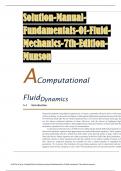Exam (elaborations)
Solution-Manual-Fundamentals-Of-Fluid-Mechanics-7th-Edition-Munson
- Course
- Institution
- Book
Numerical methods using digital computers are, of course, commonly utilized to solve a wide variety of flow problems. As discussed in Chapter 6, although the differential equations that govern the flow of Newtonian fluids [the Navier–Stokes equations (Eq. 6.127)] were derived many years ago, ther...
[Show more]



